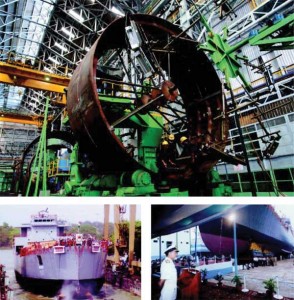 Advances in ship design and in construction technology are derived from extensive, long-term research in wide ranging fields, which involves substantial financial support, far more than is available in India. It would however, not be in our interest to re-invent the wheel; therefore strategies to incorporate the results of such research in indigenous shipbuilding need to be evolved. The JV route, with a larger share of FDI offers an avenue to meet this objective. If we are able to produce ships which offer greater operational efficiencies i.e. lower running costs and longer service life, as well as lower acquisition costs than their peers, we would be able to attract international customers.
Advances in ship design and in construction technology are derived from extensive, long-term research in wide ranging fields, which involves substantial financial support, far more than is available in India. It would however, not be in our interest to re-invent the wheel; therefore strategies to incorporate the results of such research in indigenous shipbuilding need to be evolved. The JV route, with a larger share of FDI offers an avenue to meet this objective. If we are able to produce ships which offer greater operational efficiencies i.e. lower running costs and longer service life, as well as lower acquisition costs than their peers, we would be able to attract international customers.
A distinctive feature in the commercial sector is the provision of subsidy to Indian shipyards by the Government. The continuation of this measure at least over the XIth plan is essential because of the high incidence of taxation and the high cost of capital. Without this subsidy, Indian commercial shipyards would find if difficult to remain financially viable and would not attract the investments necessary for high growth and achieving economies of scale. Once economies of scale are realized, the issue of subsidies can be reviewed.
Our shipbuilding industry requires the focused attention of the government to create conditions required for its growth. Our geo-strategic and geo-political concerns underline the need for a strong and capable Navy and Coast Guard, fully capable of safeguarding our security and economic interests. Our commercial shipbuilding sector has demonstrated its ability to compete successfully in the international market in several niche segments. This competitiveness, if extended across the board, including in high technology sectors would yield substantial returns. There is, therefore, a need to remove structural weaknesses and to create a fiscal, commercial and statutory environment, conducive to the sustained growth and self sufficiency of our shipbuilding industry. An integrated approach is necessary as half-measures would not result in any headway.
Firstly, both existing and future shipyards need to be considered as Special Economic Zones i.e. given a full SEZ status. This is necessary because ships imported by Indian owners are given full exemption of customs duty and presently custom duty of about 35 percent is levied on all capital equipment required for shipbuilding, even though this measure does not protect any industry in India. A need therefore exists to accord export status for ships built in India for Indian owners. SEZ status should also be accorded to any other ancillary industry that may come up to enable the industry to grow in clusters. This measure would attract much needed investment, and would also nurture the growth of the in land water and coastal sectors.
 Secondly a ‘single window clearance’ system needs to be brought into place for according clearance to new shipyard projects covering land acquisition, environmental clearance, power and water etc., so that project implementation is not delayed. An empowered professional authority could be set up to accord such clearances. The present requirement to obtain multiple clearances from various departments acts as a deterrent to investment.
Secondly a ‘single window clearance’ system needs to be brought into place for according clearance to new shipyard projects covering land acquisition, environmental clearance, power and water etc., so that project implementation is not delayed. An empowered professional authority could be set up to accord such clearances. The present requirement to obtain multiple clearances from various departments acts as a deterrent to investment.
Investment in R&D and in shipbuilding technology should be appropriately incentivized by according fiscal benefits analogous to those given to the pharmaceutical industry.
Rationalisation of taxes and duties and elimination of the inappropriate service tax, which only help foreign shipbuilders, should be effected. Taxation models followed by leading shipbuilding nations for their industry should be adopted.
 Custom bonded warehouse rules need to be amended, including the period for which materials can be stored, commensurate with the requirements of the industry.
Custom bonded warehouse rules need to be amended, including the period for which materials can be stored, commensurate with the requirements of the industry.
An expanding shipbuilding industry would require a large trained work force, covering all areas in the techno-economic spectrum of shipbuilding. Universities for shipbuilding technology should be created, in collaboration with universities of leading maritime nations in order to provide well trained and capable human resource, covering the entire spectrum from basic shipbuilding trade skills to high-end research.
The constraints on our shipbuilding industry as well as the opportunities available have caught the attention of government agencies and some initiatives are visible to improve the situation. However, in order to achieve concrete results within a short timeframe consideration needs to be given to forming a high-level, empowered Group of Ministers to implement corrective measures. This GoM would need to be supported by a permanent Task Force, composed of representatives from all stakeholders to draw up specific plans, draft suitable rules and regulations, obtain approvals and oversea implementation. Unless such measures are enforced with the urgency that they merit, the vision of seeing India emerge as a major shipbuilding nation would remain a mirage. If, on the other hand, the proposed measures are implemented with full vigour, the transformation of Indian shipbuilding into the top league would be assured, resulting in widespread benefit to the nation.




